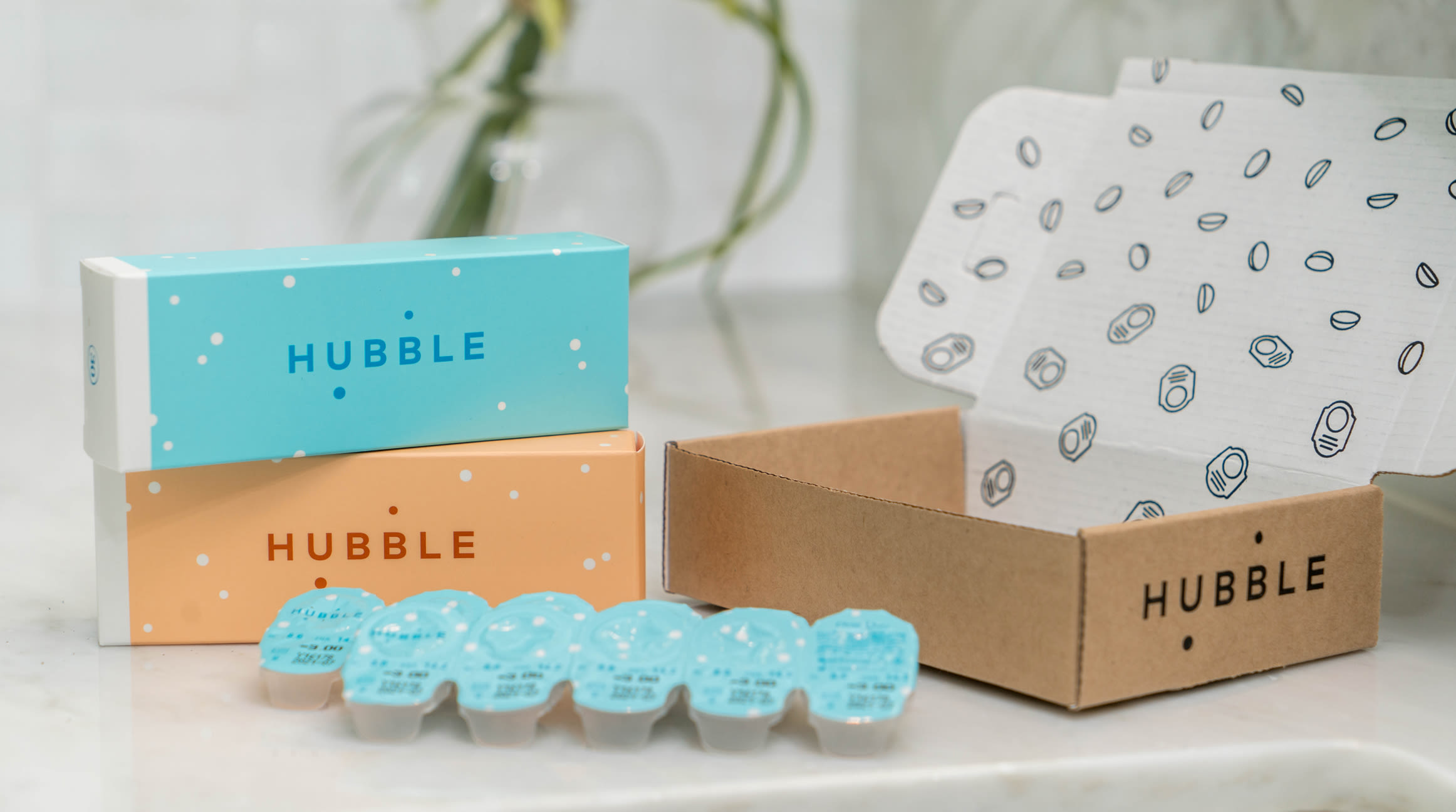Are contacts right for you?

If you're considering wearing contact lenses, you may have a few questions, predominantly whether or not contact lenses are right for you.
The best way to know if contacts are a good fit for you is to schedule a visit with an eye doctor who can conduct an eye exam. Your doctor will be able to tell you, based on your eye exam, which contact lenses, if any, are best for your vision correction needs and eye health.
Side Note: If you're in need of a doctor near you and would like to be fitted for Hubble lenses, check out Hubble's find a doctor portal and get on your way to finding a Hubble participating doctor near you today.
But, that doesn't mean Hubble can't shed some light on contact lenses to ease a bit of your uncertainty prior to your scheduled doctor's visit.
So, let's get to know contact lenses, what they correct and how, and most importantly, if they're possibly the right choice for you.
What are contact lenses?
This may seem like a common-sense question that doesn't need an explanation, but contact lenses, although a small, round clear plastic to the naked eye, are more complex than we know.
Contacts are thin clear plastic disks that float on the tear film that covers your cornea—correcting vision problems caused by refractive errors.
Side Note: A refractive error is when the eye does not bend or focus light properly into the eye resulting in blurry vision.
Contact lenses can correct various vision problems, same as eyeglasses such as:
- Myopia (nearsightedness)
- Hyperopia (farsightedness)
- Astigmatism (distorted vision)
- Presbyopia (changes to near vision that usually occur with age)
The main difference between glasses and contact lenses is that, unlike glasses that sit approximately 12 mm from your eyes, contacts sit directly on your eyes. If worn correctly and as prescribed, contact lenses can be incredibly convenient and comfortable.
Contact lenses are not a one-size/material/brand fits all, so finding the right contact lens for you can be tricky. That's why it's essential to understand the various options you have at your disposal before making your lens choice.
Contacts are made from various plastics; soft and hard contact lenses are the two most common types.
Soft Contact Lenses: Most people wear soft lenses for the variety of lens types and added comfort. Here are some types of soft lenses.
- Daily wear lenses: These are worn during the day and removed at night. Depending on whether you wear daily disposable lenses or weekly/bi-weekly/monthly lenses, these lenses are either removed and stored or disposed of at the end of each wear. Many eye specialists recommend daily disposable lenses for their convenience and added eye health benefits.
- Extended Wear Contacts: These lenses can remain on the eye even during sleep. Doctors recommend removing the lenses and cleaning them in solution at least once weekly. Eye doctors do not recommend these lenses as frequently as one-a-day wear lenses due to the possible risk of eye infections if not cleaned properly.
- Toric Contacts: These lenses are prescribed to correct astigmatism and are provided as one-a-day lenses or extended wear.
Side Note: Astigmatism is an imperfection in the curvature of your eye's cornea or lens, making your vision blurry at all distances.
Hard Contact Lenses: The most common type of hard lens is rigid gas permeable (RGP). These lenses are created from a combination of plastic and other materials. A benefit of these lenses over soft lenses is that they hold their shape firmly while still allowing oxygen to flow through the lens to the eye.
People with astigmatism and keratoconus often use RGP lenses because the lens provides sharper vision than soft lenses when the cornea is unevenly curved. This lens is also preferred by people who experience severe allergies or are prone to protein deposit build-up on their lenses.
Other types of Contact Lenses: There are also a variety of other lenses used to treat natural age-related vision problems, rare eye/vision conditions, or as a temporary bandage for the eye.
- Contacts for Presbyopia: These lenses are designed to alleviate vision problems naturally occurring after age 40 and progressing through age 65. There are different options to correct presbyopia, such as multifocal, bifocal, progressive, and monovision lenses. A person's lens type depends on their specific vision correction need and their doctor's recommendation.
Side Note: Presbyopia is the gradual loss of the eye's ability to focus on nearby objects.
- Scleral Contact Lenses: These are gas permeable (GP) lenses that stretch over the cornea and rest on the sclera (the white part of the eye) to correct vision problems that result in an irregularly shaped cornea such as corneal scars, keratoconus, or surgery.
- Hybrid Contact Lenses: These lenses have a rigid center and a soft outer ring—combining the comfort of a soft lens with the vision crispness of a hard lens. Hybrid lenses are ideal for people with corneal astigmatism or presbyopia with astigmatism. They also work well for individuals who have trouble achieving optimal vision with soft lenses or are concerned about their comfort with RGP lenses.
- Bandage Contact Lenses: These are none prescription lenses used to cover the surface of the eye for comfort after an eye injury or surgery.
How do contact lenses work?
Once you see your eye doctor, you'll receive a contact lens prescription that specifies the level of correction needed along with the parameters for the contact lens your doctor has prescribed. Contact lenses capture and reflect light to correct how your eyes process light. Once the contact is in, it redirects light into a single focal point on the retina. Then, it fine-tunes and focuses the light that enters your eyes to give you crystal clear vision.
Let's say, for example, you're prescribed contact lenses to correct Myopia (nearsightedness)—where you have trouble seeing far away because your eye focuses light in front of your retina instead of directly onto it, keeping you from seeing clearly. Your contact lens will then adjust the rays of light entering your eyes to angle further back onto your retina. Lenses designed to correct nearsightedness are thicker on the outer edges and thinner in the middle—spreading light away from the center of the lens.
A Myopia (nearsighted) prescription may look like this.

Suppose you're prescribed contact lenses to correct hyperopia (farsightedness). In that case, your eyes don't have adequate focusing power, and light rays fail to form a focus point by the time they reach the retina. Your contact lenses will correct farsightedness by converging light rays increasing the eye's focus power forward onto the retina.
A Hyperopia (farsighted) prescription may look like this.

If you're diagnosed with astigmatism, you'll most likely be prescribed a toric lens by your doctor to correct your vision. The precise shape of a toric lens creates different refractive or focusing power that can aid in correcting either a corneal or lenticular astigmatism. In addition, Toric contacts have a thicker zone keeping them from rotating when placed on the eye. Your toric lenses must provide an exact fit to your eyes to ensure crisp, clear vision at all times. If your lenses don't fit well, they'll do little to correct your vision.
A Toric lens prescription to correct astigmatism may look like this.

If you have Presbyopia—a naturally occurring, age-related loss of the eye's ability to see objects up close clearly—you'll be prescribed a multifocal/progressive lens. There are varying types of multifocal/progressive lenses, and depending on your vision correction needs, your doctor will prescribe the lens that best suit you. Multifocal/progressive lenses offer three focal points: one for reading and up-close correction, one for intermediate vision, and one for distance. Since multifocal lenses have multiple prescriptions, your eyes need a minor adjustment period to differentiate between the prescriptions. Another option people with presbyopia have is to use contacts to correct hyperopia (farsightedness) and then place their reading glasses on to see up close when needed. Someone with presbyopia may also use monovision lenses that provide a distance prescription for one eye and a near prescription for the other eye. Your prescribing doctor will be able to accurately fit you for the best lenses to correct your presbyopia to ensure you get the vision correction you deserve.
A multifocal/progressive lens prescription to correct presbyopia may look like the following.

A significant difference between how eyeglasses work and contact lenses work is that contacts move with your eye as you look around, allowing the optic zone—the part of your field of vision that your contact lens corrects—to move with you. So, unlike glasses, contact lenses never leave you with uncorrected vision at your periphery.
So, now that you understand how contact lenses correct your vision depending on your diagnosis, we can dive into different lens types and which may be best for you.
Are contacts the right choice for you?
Simply understanding how contact lenses work and what vision problems they correct may not be enough to say with certainty that contact lenses will be the right fit for you, and that's understandable. So, we'll highlight the various benefits of wearing contact lenses and which contact lens mode of wear is the safest.
We're here to help you have the most productive conversation with your eye doctor so that you can make the best decision for your eye health and vision needs.
First, let's understand who may not be a good candidate for contact lenses.
- If you're someone who doesn't produce enough tears to keep your eye adequately hydrated, contact lenses may aggravate the eyes, causing discomfort and possible infection.
- If you have a history of viral corneal infection, contact lenses are likely to irritate your eyes and increase your chances of corneal infection.
- If you're consistently exposed to fumes or pollutants that can become trapped in your contact lenses, your doctor may advise you not to wear contact lenses due to the increased risk for eye infections.
There may be other medical reasons which lead your doctor to advise you against the use of contact lenses. So, it's essential to ask as many questions as you see fit during your eye exam and divulge any and all personal and family medical history as possible.
After all, we're talking about your vision, so you don't want to leave any margin for error.
If none of the above apply to you, then let's explore the different lens types and their benefits.
Contact lens types may differ based on what they are made from (lens material), how long they are designed for wearing each day (lens schedule), and how often they should be replaced (replacement schedule). The most commonly prescribed lens types include the following:
- Lens Material: soft or hard (rigid gas permeable)
- Wear Schedule: Daily wear or extended wear
- Replacement Schedule (for soft contact lenses): Daily disposable or planned replacement
Soft lenses have these classifications based on how frequently they should be replaced/discarded:
- Daily disposable lenses: These lenses are discarded at the end of each use and replaced with a fresh pair the next time you wear lenses.
- Disposable lenses: These are discarded every two weeks or sooner and replaced by a fresh pair of lenses.
- Frequent replacement lenses: These lenses are discarded monthly or quarterly and replaced by a fresh pair that'll last another month or more, depending on your doctor's instructions.
- Traditional (reusable) lenses: These are worn for six months or longer and then discarded and replaced with a fresh pair, depending on your doctor's instructions.
All of the above lenses, except for Daily disposable lenses, require you to store your lenses in a carrying case and disinfect your lenses in solution after use and before resuming use.
If you adhere to proper care instructions given by your doctor and lens provider, you can successfully wear reusable lenses. Where you may run into trouble is if you overuse your lenses, sleep in lenses not meant to be slept in, or don't adequately disinfect/clean your lenses. If all of the designated care instructions are not met, you risk possible eye irritation/inflammation and infection.
Doctors and eye health specialists agree that the safest mode of contact wear is daily disposable lenses due to the reduced risk for eye health problems. In addition, daily disposable lenses are more sanitary for the eyes because they don't allow for build-up to occur under the contact lenses as they are disposed of at the end of the day. No need to worry about storing cases and solutions with one-a-day wear lenses; simply remove them before sleep, and rest assured that you have a fresh, clean pair waiting for you the next time you choose to wear lenses. And, if you happen to drop a lens during your busy day, there's no need to run the risk of inadequate disinfecting or cleaning; just open a fresh lens pack and safely resume your life.
The benefits of contact lenses:
We can't forget the evident convenience that contact lenses offer to our daily lives. You place your contact lenses on your eyes at the start of the day and forget about them as you go about your daily schedule with comfort, ease, and most importantly, crystal clear vision.
Contact lenses are also highly convenient and safe to wear during rigorous activities such as sports, outdoor outings, and even diving. No need to worry about cleaning or defogging your glasses again! Depending on your lens manufacturer, contact lenses also provide UVA and UVB protection for your eyes, keeping them safe from harmful sun rays. And, if you're like the many folks still needing or choosing to wear a face mask, you'll find contact lenses pair much better with masks than glasses do.
So, don't wait another minute; schedule an eye exam with your doctor and have that much-needed conversation with your prescriber to get the lenses that will best suit you.
Considering Hubble Contacts?
If you've seen the various ads or have read the countless reviews of happy Hubble customers, you may be thinking it's time to check out Hubble lenses. But, of course, as with any lens manufacturer you choose, you want to know the nitty-gritty behind the scenes of what makes their lenses great. So, let's get to know Hubble's daily disposable contact lenses.
Hubble spent over a year searching for a lens manufacturer that would align with its vision of affordability, durability, and comfort.
After traveling worldwide, visiting factory after factory, Hubble decided on St. Shine—an FDA-approved lens manufacturer. St. Shine produces millions of lenses worldwide.
The process of creating Hubble's daily disposable lenses is visionary, and the attention to detail is impeccable.
Hubble lenses are made from methafilcon A hydrogel material with 55% water content, UV protection, and a thin edge—designed for easy insertion, all-day comfort, and crystal clear vision.
They have a base curve of 8.6 and a diameter of 14.2, a UV filter, and come in powers ranging from -0.50 to -12.00 and +0.5 to +6.00. Hubble currently only offers daily disposable contact lenses because they believe, and optometrists agree, that wearing a new lens every day is safer and more comfortable.
Hubble didn't throw in the towel at affordable lenses but decided to take their reimagining of the contact lens industry one step further by providing an easy-to-manage subscription service and a $1 first box of 30 daily lenses.
Wait, there's more!
Hubble also has an easy-to-manage user-friendly customer portal, so you can effortlessly change your personal information, delivery frequency, and track your orders.
And, because Hubble knows questions and concerns do arise, they've established a 24/7 friendly and helpful customer service Chat Team.
You can reach out to Hubble's 24/7 chat line for any or all of the following:
- discussing your prescription
- help with checkout
- assistance with subscription maintenance (change of address/ replacements, etc.)
- order status
- and general questions
If you're ready to get started, speak with one of Hubble's participating doctors and schedule a fitting of Hubble's daily disposable lenses—be warned, though, that you may be hooked on Hubble moving forward.
So, don't wait another minute to get started with Hubble for just $1 and get the convenience, comfort, and eye health you deserve!


